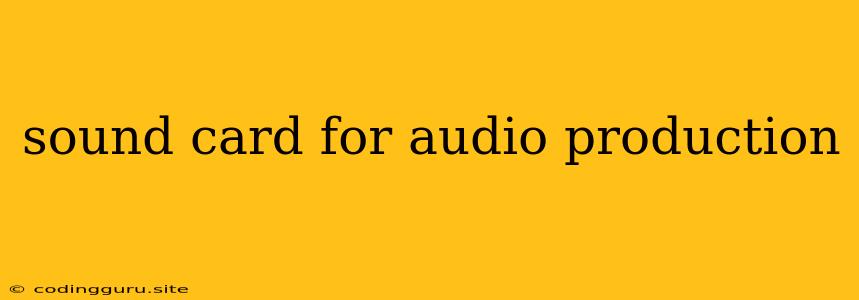Choosing the Right Sound Card for Your Audio Production Needs
So you're embarking on the exciting journey of audio production, and you've realized that a good sound card is an essential tool for capturing, processing, and outputting high-quality audio. But with so many options available, how do you choose the sound card for audio production that's right for you?
This guide will walk you through the key considerations when selecting a sound card for audio production, covering factors such as inputs and outputs, converters, latency, and features.
What is a Sound Card?
At its core, a sound card is an interface that allows your computer to communicate with external audio devices. For audio production, it's the bridge between your microphones, instruments, and other audio sources and the digital world of your DAW (Digital Audio Workstation).
Understanding Your Needs
Before you dive into the world of sound cards, it's crucial to understand your specific needs and budget. Ask yourself these questions:
- What instruments and microphones will you be using? This will determine the number and types of inputs you'll need.
- How many tracks will you be recording simultaneously? If you plan to record a full band, you'll need a sound card with multiple inputs.
- What level of audio quality are you striving for? For professional-level production, you'll need a sound card with high-quality converters.
- What features are important to you? Some sound cards offer additional features like MIDI I/O, headphone amplifiers, and onboard effects.
Key Features to Consider
Inputs and Outputs:
- Analog Inputs: These are used to connect microphones, instruments, and other analog audio sources. Look for sound cards with XLR inputs for microphones and 1/4" jacks for instruments.
- Digital Inputs: These are used to connect digital audio devices, such as optical audio interfaces and USB microphones.
- Analog Outputs: These are used to connect speakers, headphones, and other analog audio devices.
- Digital Outputs: These are used to connect digital audio devices, such as optical audio interfaces and external audio processors.
Converters:
- Analog-to-Digital Converters (ADCs): These convert analog audio signals from microphones and instruments into digital signals that your computer can process.
- Digital-to-Analog Converters (DACs): These convert digital audio signals from your computer back into analog signals for output to speakers or headphones.
- Bit Depth and Sample Rate: Higher bit depth and sample rate result in higher audio fidelity. 24-bit/96kHz is a common standard for professional audio production.
Latency:
Latency refers to the delay between the time you play a note or speak into a microphone and when you hear the sound coming back through your speakers or headphones.
- Low Latency: Essential for live recording and playing instruments in real-time.
- High Latency: Can cause noticeable delays and make recording and monitoring difficult.
Features:
- MIDI I/O: Allows you to connect MIDI controllers and instruments.
- Headphone Amplifier: Provides a dedicated headphone output with volume control.
- Onboard Effects: Some sound cards offer built-in effects, such as EQ, compression, and reverb.
Sound Card Types for Audio Production
External Sound Cards:
- USB Sound Cards: These are compact and portable, making them ideal for musicians on the go.
- Thunderbolt Sound Cards: Offer high bandwidth and low latency, making them popular for professional recording.
Internal Sound Cards:
- PCIe Sound Cards: These offer high performance and are ideal for professional studios.
Tips for Choosing the Right Sound Card
- Read Reviews: Check online reviews from other audio producers to get an idea of the strengths and weaknesses of different sound cards.
- Consider Your Budget: Sound cards range in price from a few hundred dollars to several thousand dollars. Decide how much you're willing to spend and set a realistic budget.
- Test Before You Buy: If possible, visit a music store and test out different sound cards before making a purchase.
Popular Sound Cards for Audio Production
While specific recommendations will vary based on your budget and needs, here are some examples of popular sound cards for audio production:
- Focusrite Scarlett Series: Known for their affordability, ease of use, and great sound quality.
- Universal Audio Apollo Twin: Offers high-quality converters and impressive features like UAD plugins.
- RME Babyface Pro: Renowned for their low latency and excellent sound quality.
- PreSonus Studio 1810c: A versatile option with a combination of analog and digital inputs and outputs.
Conclusion
Choosing the right sound card for audio production is an important step towards achieving the best possible sound quality for your recordings. By considering your needs, researching features, and exploring the options available, you can find a sound card that fits your budget and empowers you to create professional-quality audio. Remember, investing in a good sound card is an investment in your audio production journey!
